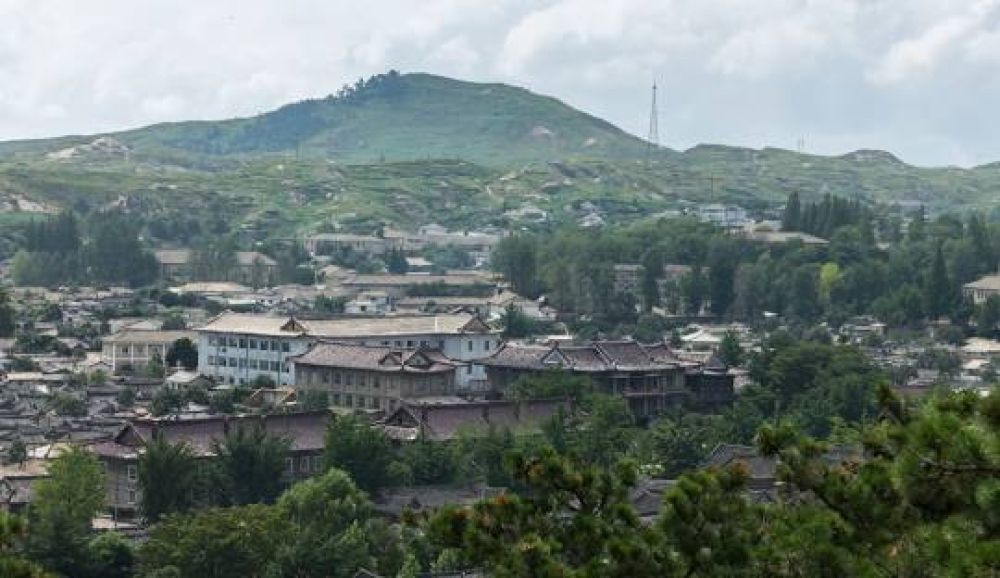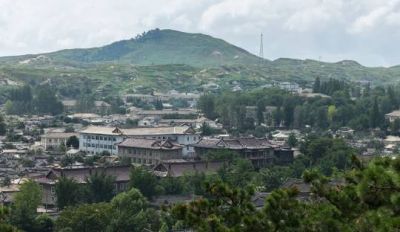

The Kaesong Koryo Museum, once a Confucian educational institution, is now a renowned museum that offers insight into the Koryo Dynasty, which ruled from 918-1392. Tourists can explore various exhibitions showcasing ancient Korean history, including pottery, porcelain pieces, and statues. Artifacts like coins, printing blocks, and national treasures present a detailed look into the period's culture and traditions. The museum's architecture, visiting the old lecture halls and student quarters, is an aesthetic experience in itself, reflecting the architectural style of the era. Surrounding the museum is the 'Street of the Old Folk Customs' which replicates Koryo-period vendors and craftsmen at work, providing a lively cultural backdrop to the visit.
Sonjuk Bridge is a small stone bridge of great historical significance located in Kaesong. It dates back to the Koryo period and was designated as a National Treasure due to its association with the renowned Confucian scholar, Jeong Mong-ju, who was assassinated on the bridge in 1392. The bridge is an embodiment of the historical narrative of the area and a symbol of loyalty in Korean culture, as Jeong Mong-ju is celebrated for his steadfast loyalty to the Koryo Dynasty in the face of the rising Joseon Dynasty. Visitors coming to this location often reflect on the country's deep historical values and the enduring legacy of its scholars. The site serves as a poignant reminder of the complex histories that have shaped the Korean Peninsula.
The Panmunjom tour is an eye-opening excursion to the demilitarized zone (DMZ) that divides North and South Korea. This tour offers a unique opportunity to see one of the most fortified borders in the world. Tourists are usually briefed on the historical and political significance of the area before visiting key landmarks such as the Joint Security Area, where North and South Korean soldiers stand face to face. The tour might extend to the 'Bridge of No Return,' where POW exchanges once occurred. This experience is heavy with the reality of division and the longing for peace in the Korean peninsula. Some tours may include a visit to the Kaesong Industrial Region. The intensity of the atmosphere and the real-life implications of geopolitical affairs make it a most thought-provoking and unforgettable experience.
Nam Gate, also known as the South Gate, is one of Kaesong's most iconic landmarks and part of the old city walls. The structure dates back to 1391 and is known for its beautiful architecture and the majestic views it offers of the surrounding city and countryside. Visitors can walk up to the top of the gate to experience these views firsthand. This gate is one of the few remnants of the old city defenses and provides context for the historical value of Kaesong as a former capital during the Koryo Dynasty. It's a spot imbued with the area's rich history and is an essential visit for those looking to delve into Korea's past.
The ruins of Manwoldae Palace, the former royal palace during the Koryo Dynasty, offer visitors a rare glimpse into the regal splendor of medieval Korea. The UNESCO World Heritage-listed site consists of the remaining foundations where the grand palace once stood, surrounded by rolling hills and scenic landscapes. Visitors can stroll around the extensive grounds where information boards provide historical context, bringing the royal courts to life. Even though the palace buildings themselves no longer stand, the vastness and layout of the foundations are a testament to the grandeur and sophistication of the period's architecture and urban planning.
The Pyongyang Folklore Park tells the story of Korea's history from ancient times through to the modern era. The park features detailed, scaled-down replicas of historical structures, monuments, and scenes from various periods of Korean history, allowing visitors to walk through the past. While technically located in Pyongyang, this park might be included on some extended tours from Kaesong. It reflects the nation's deep appreciation of its rich heritage and provides educational content in a visually engaging and interactive manner, making it a suitable destination for visitors of all ages interested in Korean culture and history.
The Tomb of King Kongmin, a 14th-century mausoleum, is one of the most elaborate and well-preserved royal tombs in North Korea. Located in the hills near Kaesong, it is the final resting place of the 31st king of the Koryo Dynasty and his queen. The site includes a series of stone statues depicting warriors and officials, which serve as guardians to the tomb. The craftsmanship is incredibly intricate, and the serenity of the surrounding landscape adds to the reverential atmosphere. Visitors come to pay homage to the historical rulers and admire the artistry of ancient Korean stonework which has survived through the centuries.
For a more hands-on cultural experience, the Janamsan Hotel in Kaesong offers cooking classes specializing in traditional Korean cuisine. Participants will learn how to prepare staples such as kimchi, pajeon (Korean pancake), and bulgogi (marinated beef) from experienced chefs. This culinary journey not only allows visitors to taste authentic flavors but also provides them with the skills to recreate dishes at home. Cooking classes offer a deeper understanding of the cultural significance of food in Korean society, as well as a fun and engaging way to interact with locals.
Philatelists and souvenir hunters alike will enjoy a visit to the Kaesong Stamp Shop. This unique location allows visitors to browse and purchase a wide variety of North Korean stamps, which are known for their intricate designs and often serve as a form of propaganda art. The stamps tell the story of the country's political history, achievements, and cultural heritage. Collecting these can be a unique way to retain a piece of North Korean history and share stories back home. Additionally, the shop often sells postcards, local handicrafts, and other memorabilia, making it a perfect spot for those looking to take a piece of their travels back home with them.
Anhwa Temple, nestled in the idyllic surroundings of the Kaesong area, represents the spiritual heritage of North Korea. The peaceful temple complex, dating back to the Koryo Dynasty, offers a serene escape from the hustle and bustle of city life. The journey to Anhwa Temple is an excursion through scenic hills and valleys, allowing visitors to appreciate the beauty of the Korean landscape. Once at the temple, tourists can explore ancient Buddhist relics, engage with the monks, and learn about the temple's history and significance in Korean spirituality. It's a reminder of the devotion and tranquility that has characterized parts of North Korea for centuries.
